Linda Fleming
THE ARTIST OF EMERGENCE
Abby Rumsey
Emergence—the study of complexity and of complex systems, of how order arises from chaos and chance—has been a subject central to Linda Fleming’s art from her salad days, long before natural science had coined a term for it. For scientists, emergence is the new paradigm that promises to reveal how galaxies arise from cosmic dust and human consciousness from electrochemical processes in the brain, topics only recently accessible to them with high throughput computing. For Fleming, is has always been close at hand, accessible through pencil and paper, wood and steel. Fleming sees emergence both as a state of being—evanescent, unforeseeable, and unrepeatable—and a way of working. In the drawings on display here she probes the dynamic of two dimensions experienced as three and time experienced as movement caught in stasis.
Many people think of drawings as emergent: the drawing is something that is on the way to a complete work, and from the drawing we expect to see another work emerge. In Fleming’s case, we expect to see her drawings as studies for her masterful three-dimensional works. It is true that many of her drawings bear a distinct relationship with her sculpture, but the relationship is seldom one of direct descent from two dimensions to three, from drawing to solid object. Fleming’s drawings are emergent in the sense that human consciousness is—drawing is both her way of thinking, and a record of thinking. But so, too, is her sculpture and photography. The result of her bearing down on a problem is “materialized thought,” she says, an embodied idea. Her works are not hermetic philosophical statements, but acts of consciousness that can only be understood by having us think the thought and experience the idea as she does.
*****
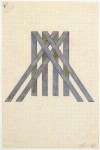 In a retrospective, we might also expect to see the artist emerge from the person. This exhibition allows us to read a narrative of how a young woman became a mature artist. We look at her early work in the light of her later creations to grasp where her mature work “comes from.” We see Fleming, who began as a painter interested in space, experimenting in her early 20s with color. In her pivotal Drawing 1969-2 , we are startled by a third dimension emerging from the flat surface of graph paper. Like a magician wielding a wand, Fleming deftly conjures forth another dimension with the subtle use of colored pencils. Yet she says she was “never interested in the illusion of space, but in space itself.” Flat color interested her is “a possibility of space,” and space itself fascinated her as a possibility of completeness.
In a retrospective, we might also expect to see the artist emerge from the person. This exhibition allows us to read a narrative of how a young woman became a mature artist. We look at her early work in the light of her later creations to grasp where her mature work “comes from.” We see Fleming, who began as a painter interested in space, experimenting in her early 20s with color. In her pivotal Drawing 1969-2 , we are startled by a third dimension emerging from the flat surface of graph paper. Like a magician wielding a wand, Fleming deftly conjures forth another dimension with the subtle use of colored pencils. Yet she says she was “never interested in the illusion of space, but in space itself.” Flat color interested her is “a possibility of space,” and space itself fascinated her as a possibility of completeness.
Completeness has been the puzzle that captured her attention as a child and has held it fast for decades. Fleming uses art to pursue her curiosity about “how things fit together” and cohere. Space is the essential dimension that solves the puzzle. She begins with a vision of something whole in her mind and proceeds to work up from component parts—not like an engineer, taking apart a machine to find out how it works; nor a scientist reducing an integral phenomenon to its elements and particles to understand the laws it obeys. She inverts mechanistic and reductivist processes by beginning on the ground with elements and working upwards, from simplicity to complexity, from a line on paper or an arc of steel to a work. What we see in this exhibition are questions emerging as drawings.
Her double view—the telescopic and the microscopic operating simultaneously—presents the whole and its elements simultaneously. This binocular focus creates a curious disquiet in the viewer, a precarious sense of equilibrium about to yield to movement. As if to ward off vertigo, we follow her thoughts with our eyes as we move continuously between our wonder at the whole and fascination with the parts. Before we know it we have accepted the invitation to explore the work at the smallest scale as well as the biggest. We see the horizon and we see the foreground. We become the middle ground.
*****
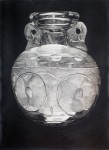 This double view is vividly transparent in her series of Roman glass antiquities, highly detailed and intricately articulated drawings of glass objects excavated in present-day Germany, once the periphery of the Roman Empire. Fleming undertook this series in 1989 after a hiatus from drawing, a period when she felt her technique might obscure the thought process that forms the true subject of her work. By starting not with the sculptural objects themselves but photographs of them, then enlarging the images again and again—digging deeper and deeper at smaller and smaller scales in her own pictorial excavation—she lights up new spheres of complexity. Here her phenomenal technique is fully at the command of her composing, every stroke drawing us deeper and deeper into her investigation of light, solidity, transparency, and opacity. We can no more resolve the mystery of glass and the glassmaking process to a sum of chemicals transformed by energy than we can resolve the mystery of who made these vessels and why, how were they used and why they were buried in the ground. But as Fleming recreates them through careful observation and unbounded imagination, we can sense how the glass vessels were fitted together by unknown human hands, traveled through time protected by an encapsulation of damp earth, dug up and reassembled from shards by master restorers. They now tower over us in these stunningly luminescent drawings demanding our attention and letting us bask in their light.
This double view is vividly transparent in her series of Roman glass antiquities, highly detailed and intricately articulated drawings of glass objects excavated in present-day Germany, once the periphery of the Roman Empire. Fleming undertook this series in 1989 after a hiatus from drawing, a period when she felt her technique might obscure the thought process that forms the true subject of her work. By starting not with the sculptural objects themselves but photographs of them, then enlarging the images again and again—digging deeper and deeper at smaller and smaller scales in her own pictorial excavation—she lights up new spheres of complexity. Here her phenomenal technique is fully at the command of her composing, every stroke drawing us deeper and deeper into her investigation of light, solidity, transparency, and opacity. We can no more resolve the mystery of glass and the glassmaking process to a sum of chemicals transformed by energy than we can resolve the mystery of who made these vessels and why, how were they used and why they were buried in the ground. But as Fleming recreates them through careful observation and unbounded imagination, we can sense how the glass vessels were fitted together by unknown human hands, traveled through time protected by an encapsulation of damp earth, dug up and reassembled from shards by master restorers. They now tower over us in these stunningly luminescent drawings demanding our attention and letting us bask in their light.
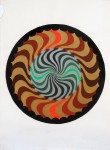 When Fleming works directly in three dimensional space, she invites us to explore space through her sculptures literally, with our bodies, to walk around and very often to walk within, to look at the piece from the outside, and experience the piece from the inside, ourselves again the middle ground. But her work is as much about time, the fourth dimension, as it is about depth, length, and height. In the Spaceball series from the mid-70s—also begun after a significant hiatus from drawing—she works through the puzzle of scientific cosmology that posits a universe that is expanding, but may also contract, collapse, and burst forth again in regeneration. That universe is bounded by the limits of expansion and contraction. These drawings are the artist’s rendering of that bounded universe, and they bear distinct archetypal affinities to religious cosmological images from medieval mappa mundi and Eastern mandalas and to Southwest Indian sand paintings. Yet these resemblances derive from correspondences, not artistic influences, and are all the more powerful because they testify to the steadfast and unyielding attempt by humankind across time and place to understand how the world fits together.
When Fleming works directly in three dimensional space, she invites us to explore space through her sculptures literally, with our bodies, to walk around and very often to walk within, to look at the piece from the outside, and experience the piece from the inside, ourselves again the middle ground. But her work is as much about time, the fourth dimension, as it is about depth, length, and height. In the Spaceball series from the mid-70s—also begun after a significant hiatus from drawing—she works through the puzzle of scientific cosmology that posits a universe that is expanding, but may also contract, collapse, and burst forth again in regeneration. That universe is bounded by the limits of expansion and contraction. These drawings are the artist’s rendering of that bounded universe, and they bear distinct archetypal affinities to religious cosmological images from medieval mappa mundi and Eastern mandalas and to Southwest Indian sand paintings. Yet these resemblances derive from correspondences, not artistic influences, and are all the more powerful because they testify to the steadfast and unyielding attempt by humankind across time and place to understand how the world fits together.
*****
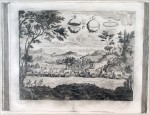 Given the centrality of drawing to Fleming’s creative process, it is remarkable that she has gone through several periods in which she drew little or nothing at all, times when she vacillated between using her skill at draftsmanship as a path into an object and her anxiety that the skill would derail her, lead her astray and render thought less visible rather than more. Yet this indecision is itself vital to her creative process because each time she starts drawing again, she arrives quickly, decisively, at a reinvigorated exploration of space in time. Her series Iconismus from 1997, also initiated after a break from drawing, is the most powerful statement to date of her artistic purpose and identity. The proximate inspiration for these works depicting early modern scientific and engineering feats are illustrations she saw in a series of rare natural science books lent by her friend Rick Watson.
Given the centrality of drawing to Fleming’s creative process, it is remarkable that she has gone through several periods in which she drew little or nothing at all, times when she vacillated between using her skill at draftsmanship as a path into an object and her anxiety that the skill would derail her, lead her astray and render thought less visible rather than more. Yet this indecision is itself vital to her creative process because each time she starts drawing again, she arrives quickly, decisively, at a reinvigorated exploration of space in time. Her series Iconismus from 1997, also initiated after a break from drawing, is the most powerful statement to date of her artistic purpose and identity. The proximate inspiration for these works depicting early modern scientific and engineering feats are illustrations she saw in a series of rare natural science books lent by her friend Rick Watson.
Fleming has long been fascinated by scientists and engineers, people who, like herself, make things and break things, sketch objects and construct objects in order to understand how materials and energies compose the world. What she sees in these whimsical, highly imaginative, yet descriptively precise large-scale engravings are fellow travelers in the exploration of space and time. The early modern natural philosophers whom Fleming admires and studies drew no distinction between art and science, imagination and reason, as we do today. Both the artist and the natural historian must command their ability to attend to events and objects that present themselves as seamless natural phenomena but in reality are aggregations of atoms and subatomic particles whose logic we are only beginning to glimpse. What we see in Fleming’s work in toto here on display is what she sees in the scientists—a brave, almost reckless curiosity and desire for beauty, disciplined by an aesthetic intelligence that sees beauty as inseparable from knowledge.

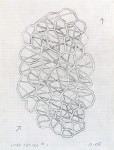 Just as the scientists she draws are enacting a public demonstration of discovery, Fleming creates her art as a public demonstration of thought. Her drawings are the result of a process, a sampling in time and material of that process, but not the end of the thought. Her fascination with how order arises from chaos by way of chance recurs in her most recent drawings, Gray Fog, Smoke Creek, Puff, Loopy, and Ping. The figures are suggestive of matter undergoing phase transition—dirt turning into swirls of dust, icicles melting into vapor, light exploding into refracted shards. The shapes are caught in a moment of repose and equilibrium before concentrating their kinetic energy and spinning off into another state. Like contemporary cosmologists who conceive of the universe as multi-dimensional strings that vibrate to create the universe we see around us, Fleming here depicts the world as energized matter in space. The artist gives us a public demonstration that the multi-dimensional universe we see around us is the universe within us. Like beauty and knowledge, they are inseparable forms of consciousness that meet in us, the middle ground.
Just as the scientists she draws are enacting a public demonstration of discovery, Fleming creates her art as a public demonstration of thought. Her drawings are the result of a process, a sampling in time and material of that process, but not the end of the thought. Her fascination with how order arises from chaos by way of chance recurs in her most recent drawings, Gray Fog, Smoke Creek, Puff, Loopy, and Ping. The figures are suggestive of matter undergoing phase transition—dirt turning into swirls of dust, icicles melting into vapor, light exploding into refracted shards. The shapes are caught in a moment of repose and equilibrium before concentrating their kinetic energy and spinning off into another state. Like contemporary cosmologists who conceive of the universe as multi-dimensional strings that vibrate to create the universe we see around us, Fleming here depicts the world as energized matter in space. The artist gives us a public demonstration that the multi-dimensional universe we see around us is the universe within us. Like beauty and knowledge, they are inseparable forms of consciousness that meet in us, the middle ground.


